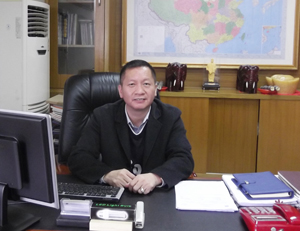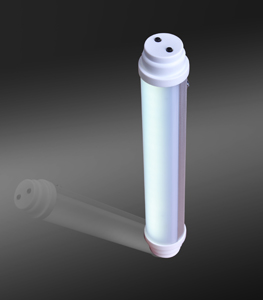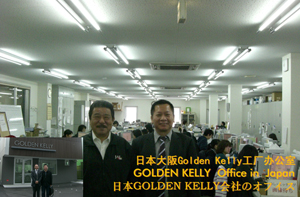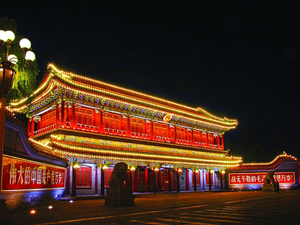China's LED Lighting Future Brightens with Government Support
Beijing pushes eco-solutions in Five-year Plan
2012/03/08 | By CENSThe LED lighting market in China is expected to grow rapidly in the years to come buoyed by support from both the government and private sectors.
As part of the country's 12th five-year development plan, the Government Office Administration of the State Council has been promoting eco-friendly, high-efficiency lighting. Its goal is to achieve a replacement of all conventional lighting in office buildings, which would mean a total of 25 million units of various kinds of new lamps with high energy efficiency, high reflectivity, reasonable light distribution, and that can be connected to smart controlling devices. Out of this total amount of new lamps, more than 10% of them would be LED lighting.

The government's ongoing efforts to promote green lighting nationwide are expected to help stimulate the development of the domestic market for LED lighting. In Beijing, a city where lighting consumed 75 trillion kWh of electricity in 2009, the Chinese government plans to reduce power consumption by 30% before 2015 by increasing the use of replacement energy-saving lighting. It is estimated that this should help generate business opportunities worth approximately RMB9 billion for LED and LED lighting suppliers.
According to government officials, between 2011 and 2013 the number of street lamps installed in Beijing with an LED light source will increase to 130,000 units. And over 10 million units of various kinds of LED indoor lighting will be installed in subways, tunnels, underground spaces and large public buildings in the city.
Demand Rises and Prices Fall
In the short-term, global prices of 60W LED bulbs are expected to continue to drop, which, in turn, will accelerate the replacement of traditional incandescent lamps around the country.
According to a market report by the LED market researcher LEDinside, in December 2011 the average global price of 60W LED bulbs declined 15% monthly to US$33.5 per unit. In Korea, the price even fell to a low of US$18.9. In the United States and Japan, lighting unit prices dropped 17 and 15%, respectively.
The LEDinside report stated that following a sharp drop a month earlier, the global price of 40W LED bulbs continued to spiral downward to US$11.1, with the most significant drop in price worldwide occurring in Japan.

The market researcher says that the fierce competition among of LED bulb suppliers has driven prices lower for bulbs replacing 60W incandescent bulbs. It also noted that lighting in that wattage category comprises the majority of light bulb sales worldwide, motivating global tap that market through competitive pricing.
Some industry insiders expect the global LED lighting market to take off in 2012 as retail prices fall. However, to stay competitive, suppliers need to develop technologies to reduce production costs, while also staying attractive to buyers in different markets, each of which may have unique requirements in terms of lighting brightness and color temperature.
Public and Private Partnership
It is possible that the formation of the China Semiconductor/LED Industry and Application Alliance on January 6, 2012, was due to a growing concern among local manufacturers about synergy. These local manufacturers have been partners of the government in its efforts to promote LED lighting. According to one of these partners, the Alliance plans on innovating technologies and creating a solid supply chain in the country by coordinating resources among different companies.
Due to the government's efforts, in 2011 China's LED industry manufactured RMB154 billion worth of products, up 22% from a year earlier and with output volume surging 50%. This indicates that the industry has developed rapidly and that companies have been successful in achieving the same level of manufacturing capability and capacity as their foreign competitors. Also, product applications have been extended from indicator lights and landscape lighting to backlights for large LCD TVs and monitors, auto lamps, streetlights and ordinary lighting. As a result of technological developments and a greater variety of products reaching the market, the industry's output is expected to grow 30% in 2012.
Industry insiders have become increasingly optimistic that in the short-term lighting will lead the growth of the global LED market. The primary reasons for this optimism have been that in 2012 over two-thirds of countries worldwide are expected to ban the use of incandescent lamps and high-watt incandescent lighting, the increase in government subsidies for purchases of LED lighting, and consumer interest in eco-friendly products.
According to some industry insiders, ambient lighting has shown the largest market potential among LED lighting applications. And the figures speak for themselves: out of the RMB600 billion in overall lighting sales worldwide in 2010, ambient lighting products amounted to RMB450 billion, and the market penetration rate of LED lighting is expected to increase from an estimated 20% in 2013 to 50% in 2020.

As the world's largest manufacturing base of consumer electronic devices, China is expected to enjoy sustained demand for LED backlights in the years to come. It is estimated that in 2015 backlights will command a 55% share of the total shipment of LED applications.
Exporters Increasingly Prefer Local Suppliers
Due to improvements both in technology and quality, local exporters have increasingly preferred Chinese suppliers, such as ShenZhen BCX Opto-electronic Technologies Co., Ltd..
Founded in 2006, ShenZhen BCX has developed, manufactured and promoted LED lighting and related products, and is well known as one of the foremost Chinese manufacturers of LED flexible strip lights with waterproof standard IP65 certification. Since 2009 when it started focusing on light tubes, the company has expanded its global presence. Its products have been well received in Japan, Europe and North America, and the success of the company's own LED lighting brand has been especially notable in Japan.
Among the company's most successful products is its T8 light tube, whose light source consists of extremely high-brightness LEDs. The tube is made of high-quality PC (polycarbonate), and its waterproof structural and decay-resistance designs provide enhanced durability when used outdoors. In addition to having a high electrical safety feature, the circular light tube is easy to install for an optimal light distribution. It is suitable for use in mansions, large office buildings and bridges, or along with LED signage as an ideal urban-light solution. Recently, the company launched a multi-purpose portable 2.2W LED light tube that serves as an easy-to-carry emergency light for outdoor activities.
Company General Manager Tsai Yahui said that through learning from its Japanese partners about the most recent technologies and market information it has been able to focus its R&D on what has been happening in the ever-changing market. Tsai said that "we have planned to cooperate with LED chipset manufacturers and packagers known worldwide both to increase vertical integration in the industry and to lower production costs."

To boost its brand recognition among consumers and enhance its reputation for quality assurance, the company, whose products have been certified by Underwriters Laboratories Inc. (UL), has applied for VDE certification through the Association for Electrical, Electronic and Information Technologies, and expects that approval will happen at the end of February at the earliest.
The company plans to invest some RMB1 million to build an in-house R&D lab and acquire over 3,000 square meters of land to expand its factory this year. Starting in May, it intends to automate all of its manufacturing and packaging production lines. Tsai said that production automation will help the company sharply cut labor costs to remain competitive, which will become important especially in the next few years when unit prices of 40W LED lighting products are likely to drop between 30 and 40%. Improving product quality and cutting production costs are two ways that the company sees itself as a trustworthy supplier.
According to Tsai, current prices have caused Chinese consumers to be less interested in LED lighting than have Japanese buyers. However, he said that with strong promotional support from the government, LED lighting would become widely accepted by local consumers in less than three years. In February alone, the company plans on opening 30 franchise stores in Shenzhen, and in the short-term the number will grow to between 200 and 300. Tsai said that in three years the company intends to have opened 2,000 franchise stores nationwide, which should be effective in promoting its LED lighting products.
More Private LED Companies Go Public
An increasing number of companies in China's LED lighting industry have undertaken an initial public offering (IPO). Since the end of January, more than 40 companies in the industry have undertaken IPOs, and over 20 of them will be listed publicly at the end of this year.
Since the beginning of 2010 and influenced by the increasing role of eco-friendly lighting in the industry, the number of LED chipset packagers and LED application suppliers that have undertaken IPOs has increased steadily. In the past, the first public stocks companies sold were for monitor LEDs and landscape lights. Today more companies going public focus on general lighting, industrial lighting and electronic device backlights, which between 2013 and 2014 are expected to become the industry's leading products.
Local lighting manufacturers have increasingly been seeking sustainable development through applying LEDs in production, building outlets and owned brands. For instance, a traditional lighting product manufacturer, NVC Lighting Technology Co., Ltd., has succeeded in obtaining a solid position in the country's LED lighting sector after years of focus on branding and distribution. And local household appliance brands such as TCL, Haier and Midea have also become part of the industry competition. Competition itself will motivate the companies in the industry to develop their technologies, which will cause selling prices of LED lighting to drop faster and attract more consumers. Considering the transition that the industry has been undergoing, the optimism of industry insiders about the short-term future of China's LED lighting market makes sense.

